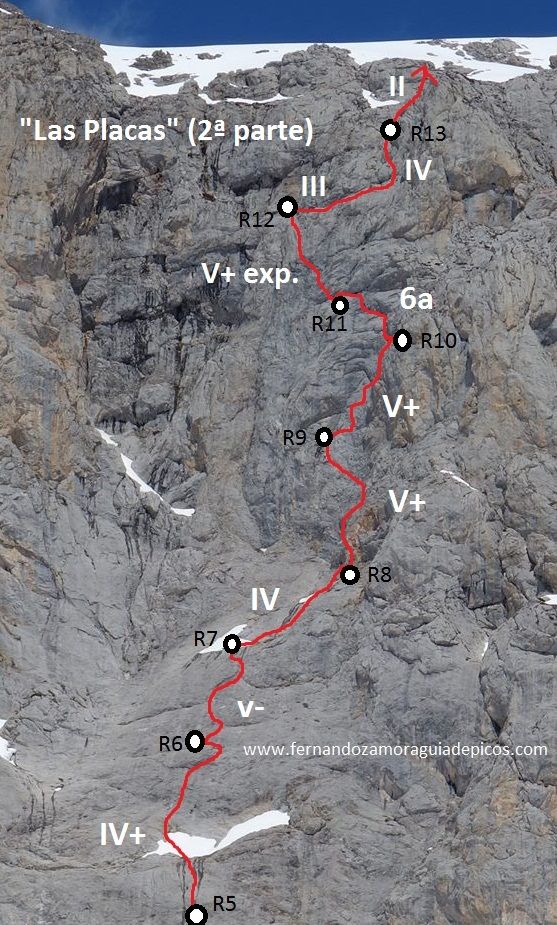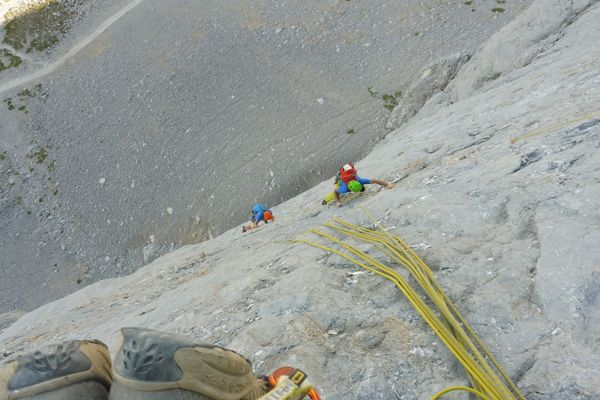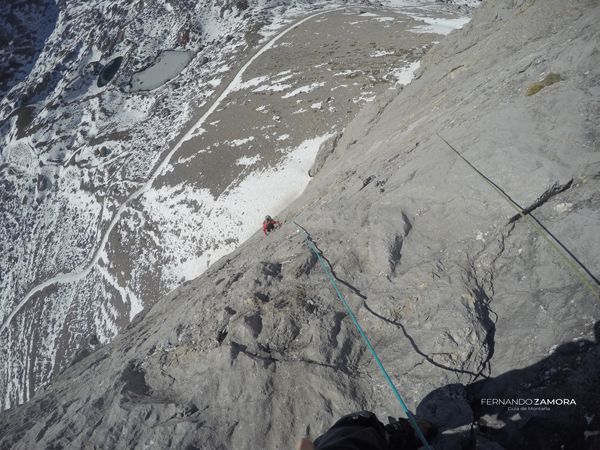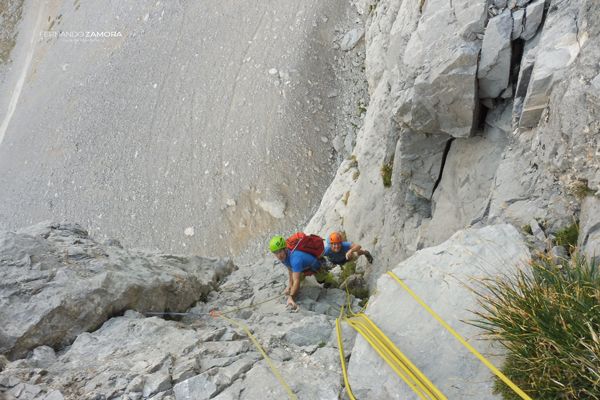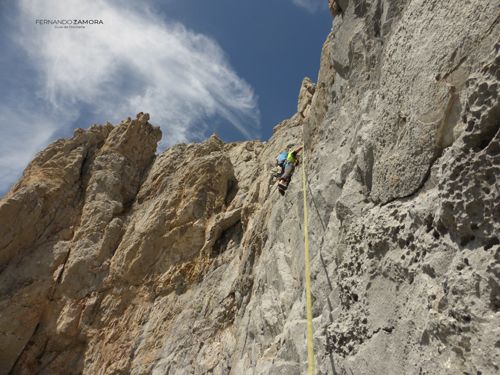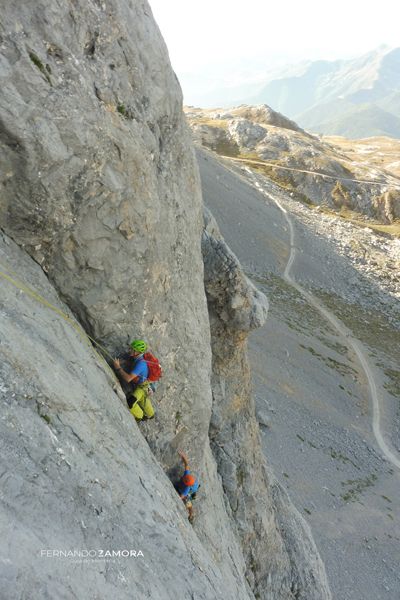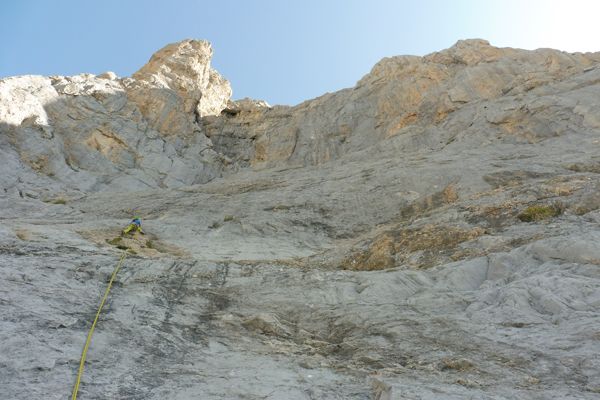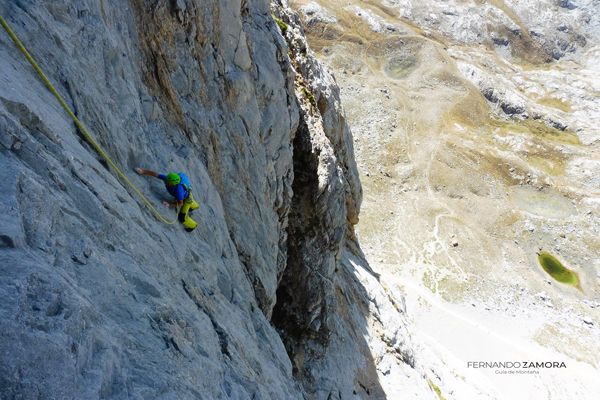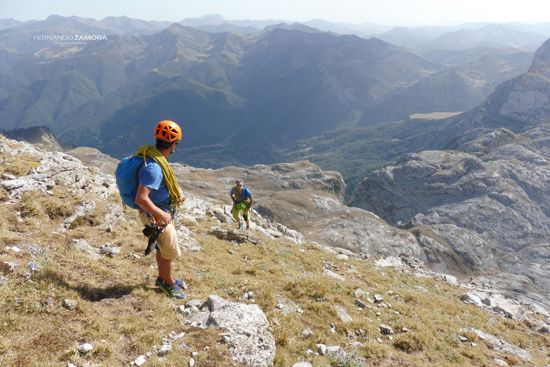The route of Las Placas de Peña Olvidada is one of the great classics of moderate difficulty in Picos de Europa and probably the most emblematic in the Fuente Dé area.
It is impossible for Peña Olvidada to go unnoticed by a climber upon arrival at the upper station of the Fuente Dé cable car. However, due to the age of many of its routes, the lack of information, the rock which can sometimes be a little stressful, and above all the character of most of its routes, it is rare to see roped parties climbing this wall of more than 400m length. Many of its routes are still awaiting their first repetition, even though they are only a few minutes' walk from the cable car.Peña Olvidada has forged the character of the main openers in the Fuente Dé area, combining a very active past on this wall with the techniques and objectives of that time with the most modern styles of today. The route of las Placas is a clear example of this.
Peña Olvidada may not have the excellence of other neighbouring walls in the Picos de Europa, it may not appeal to everyone, but it is undoubtedly one of the greatest adventure areas in the Picos de Europa.
When you look at the description of the Las Placas de Peña Olvidada route, ypu'll discover a long but not too demanding route, but you need to keep in mind that it should not be underestimated. The grade is not high but the pitches are quite sustained. There are not many protection possibilities apart from the anchors already in place, and although the rock is generally good, it is still mountain terrain where we will have to climb with tempering in some sections. To give an idea, it is listed as an ED.inf. route. A highly recommended little adventure. A route that every keen climber has to know.
Most of the track has recently been re-equipped. The pitches have been cleared of dangerous blocks and boulders, all the old burils and spits have been replaced with 10x90mm stainless steel bolts and many cordelettes have been renewed, mainly in the first part. No new expansion bolt has been added. It is a good idea for the roped parties to take some cordelettes to restore those on the pitons of the second section, as they help a lot to follow the itinerary.
ROUTE OF LAS PLACAS DE PEÑA OLVIDADA, ROUTE DESCRIPTION:
- The first pitch is a very nice vertical wall semi-equipped with pitons and rock tunnels. It is possible to connect it with the second pitch that climbs up a kind of couloir-ledge where the difficulty decreases.
- The third pitch is a traverse to the left up to a slab that concentrates the greatest difficulty of the pitch and where a piton is left a little way off. After that we get to a rugged but secure dihedral.
- Fourth pitch: Very beautiful and sustained. It starts with an almost descending traverse and then climbs up a nice wall where you have to pay attention to the rock, but that is quite manageable. It is difficult to place protections in addition to those already in place.
- Fifth pitch: We continue along a small, rugged dihedral with little protection until we reach a ledge that we cross to the right in search of a compact slab.
- Sixth, seventh and eighth pitches: Cross the central slabs with little protection but good rock in general. Pitches 7 and 8 can be connected with 3-5 metres of simul climbing.
- Ninth pitch: from here the route gains verticality again. A first vertical and athletic section leads us to a very nice traverse slab on good rock. Set up the belay station using a rock tunnel and a piton that can be reinforced with a yellow Camalot.
- Tenth pitch: start traversing and then climb diagonally, avoiding the most vertical areas. You have to meander a bit to find the easiest itinerary, some pitons will guide you along the way. Stylish opening. Very good rock.
- Eleventh pitch: Very nice. Diagonal to the left, avoiding the upper overhangs. Fairly good rock but challenging for both leader and second climber.
- Twelfth pitch: Do not underestimate it. A beautiful vertical wall with little chance of placing protection. It has good holds, but the anchors are far away. A rock tunnel located about 15-20 m from the belay station will attest that we're on the right way.
- Finally, the last pitch is a horizontal traverse to the right until getting to a piton protecting a small bulge that leads to a much easier area. Watch out for rope chafing. Belay station on a rock tunnel almost at the top of the rope, which is reinforced with friends.
- Descent: once you have reached the last belay station, continue walking to the summit and then northwards until you find a steep stony slope. Descend it (follow the cairns) in search of a hidden couloir, where there are three rappels installed that lead to the long rocky area above La Vueltona (see topo).
FACT SHEET
LENGTH
DIFFICULTY
DURATION
EQUIPMENT
DESCENT
FIRST ASCENT




